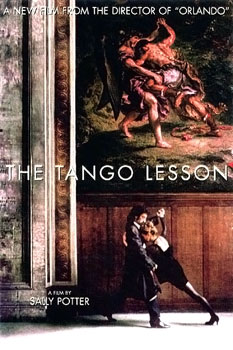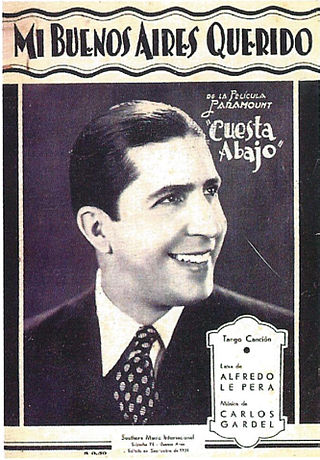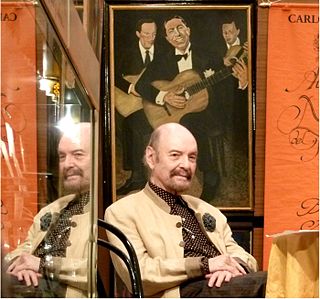
Carlos Gardel was a French-born Argentine singer, songwriter, composer and actor, and the most prominent figure in the history of tango. He was one of the most influential interpreters of world popular music in the first half of the 20th century. Gardel is the most famous popular tango singer of all time and is recognized throughout the world. Described variously as a baritone or tenor because of his wide vocal range, he was known for his rich voice and dramatic phrasing. Together with lyricist and long-time collaborator Alfredo Le Pera, Gardel wrote several classic tangos.

The Tango Lesson is a 1997 drama film written and directed by Sally Potter. It is a semi-autobiographical film starring Potter and Pablo Verón, about Argentinian Tango.

Aníbal Carmelo Troilo, also known as Pichuco, was an Argentine tango musician.
Alfredo Le Pera was a Brazilian-born Argentine journalist, dramatist, and lyricist, best known for his brief but fruitful collaboration with the renowned tango singer Carlos Gardel. He died in a plane accident with Gardel when he was at the height of his career.

Enrique Santos Discépolo (Discepolín) was an Argentine tango and milonga musician and composer, author of famous tangos like Cambalache and many others performed by several of the most important singers of his time, amongst them notably Carlos Gardel. He was also a filmmaker, actor and screenwriter.

Gerardo Hernán Matos Rodríguez, also known as Becho, was a Uruguayan musician, composer and journalist.

María Amelia Baltar, better known as Amelita Baltar, is an Argentine singer, one of the leading voices of tango, that appeared in the 60's to be considered, along with Susana Rinaldi, as a modern counterpart of older divas such as Libertad Lamarque and Tita Merello. She is mostly known for her collaboration with composer Astor Piazzolla and writer Horacio Ferrer, specially as first performer of their song “Balada para un loco”. She starred in places such as Olympia (Paris), De Kleine Komedie (Amsterdam), Cemal Reşit Rey Concert Hall, Cocoanut Grove at Ambassador Hotel or Ginásio do Maracanãzinho and shared the stage with celebrities such as Charles Aznavour, Franck Pourcel, Henry Mancini, Gerry Mulligan, Gary Burton and Chick Corea.

Samuel Castriota was an Argentine pianist, guitarist and composer. He is the composer of the tango Mi noche triste, among other works.

Pascual Contursi was an Argentine poet, singer, and guitarist. He composed lyrics for 33 tango compositions – many well-known.

"La cumparsita" is a tango written in 1916 by the Uruguayan musician Gerardo Matos Rodríguez, with lyrics by Argentines Pascual Contursi and Enrique Pedro Maroni. It is among the most famous and recognizable tangos of all time. Roberto Firpo, director and pianist of the orchestra that premiered the song, added parts of his tangos "La gaucha Manuela" and "Curda completa" to Matos' carnival march, resulting in "La cumparsita" as it is currently known. "La cumparsita" was first played in public in the old Café La Giralda in Montevideo, Uruguay. The Tango Museum of Montevideo stands currently on that site.
Otros Aires is an Argentine 21st-century tango music group founded in 2003 in Barcelona by Argentine musician and architect Miguel Di Genova.

'Mi Buenos Aires querido' is a tango with music by Carlos Gardel and lyrics by Alfredo Le Pera, released in 1934. It is featured on the soundtrack of its eponymous movie directed by Julio Irigoyen.
Víctor Hugo Díaz was a tango, folklore and jazz harmonicist.

Terig Tucci was an Argentine composer, violinist, pianist, and mandolinist.

Elías Isaac Alippi was an Argentine actor, theatrical impresario, film director and theater director, who was born and died in Buenos Aires. He is also remembered as an excellent tango dancer.

Horacio Arturo Ferrer Ezcurra was a Uruguayan-Argentine poet, broadcaster, reciter and tango lyricist. He is particularly well known for having composed the lyrics for tangos by Astor Piazzolla, such as Balada para un loco and Chiquilín de Bachín.

Azucena Maizani was an Argentine tango singer, composer and actress who was born in Buenos Aires on November 17, 1902, and died in the same city on January 15, 1970. She was discovered in 1920 by Francisco Canaro and quickly emerged as a major star. Her frequent appearances on stage and radio made her the female counterpart of Carlos Gardel although she did not enjoy as successful a film career as he did, appearing in a handful of films including Buenos Aires Sings (1947). During many years she gave performances dressed with men's suits or criollo cowboy attire for which she was known by the nickname "Funny-face Cowgirl", given to her by Libertad Lamarque in 1935.
Augusto Umberto Gentile, also known as Augusto Alberto Gentile was a pianist and composer of Argentine tangos. Gentile was born in Rome, Italy and signed his middle name "Alberto" because he preferred it to "Umberto". Around 1913, he began to compose tangos. As a performer, he recorded some tangos on piano solo for the "Telephone" label in 1918, and he was also artistic director for that label. He worked with lyricists such as Pascual Contursi and Juan Andrés Caruso. Gentile died in Buenos Aires, Argentina.
Adiós muchachos is a 1927 Argentine tango song composed by Argentinian pianist Julio César Sanders and Argentinian poet César Vedani.
Benjamín Alfonso Tagle Lara was an Argentine lyricist and composer of tangos who achieved popularity in the 1920s.















